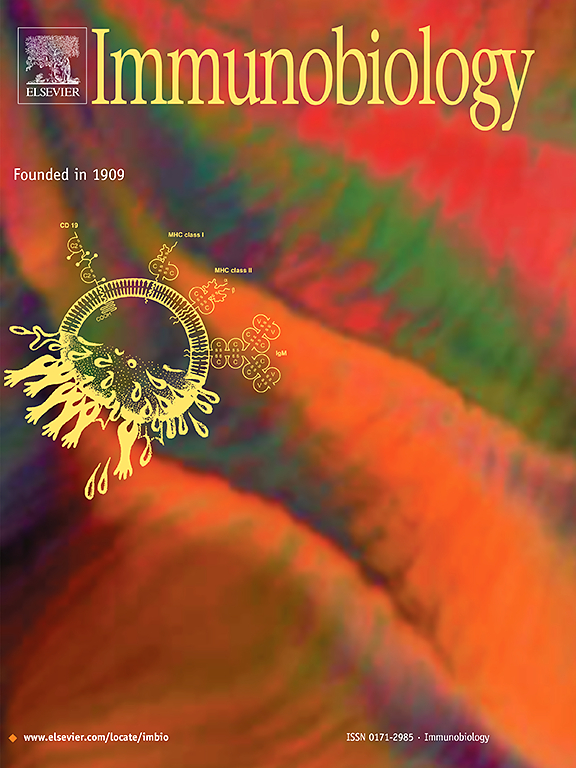Qufeng epimedium decoction alleviates rheumatoid arthritis through CYLD-antagonized NF-kB activation by deubiquitinating Sirt1
IF 2.3
4区 医学
Q3 IMMUNOLOGY
引用次数: 0
Abstract
Background
Rheumatoid arthritis (RA) is a chronic autoimmune disease that markedly limits the patients´ day-to-day functional abilities and life quality. Currently, there is no known cure for RA. Qufeng epimedium decoction, a traditional Chinese medicine, is widely used in China to treat RA. However, its underlying mechanism remains elusive.
Methods
The RA animal model was established to investigate the anti-RA effect and regulatory effect on fibroblast-like synoviocytes (FLS) pyroptosis, qRT-PCR, Western blot, flow cytometry, histology staining, and ELISA were utilized to confirm the gene and protein expressions. The interactions between Sirt1 and CYLD were validated through Co-immunoprecipitation (Co-IP) and RNA-FISH assay.
Results
Administration with Qufeng epimedium decoction attenuated inflammatory damage, excessive proliferation, and FLSs pyroptosis in an RA rat model. Moreover, treatment of Qufeng epimedium decoction reduced the ubiquitination modification level of Sirt1 in FLSs isolated from an RA rat model. Mechanistically, CYLD, an intermediation for linking Qufeng epimedium decoction and RA, was responsible for Sirt1 deubiquitination to its protein stabilization, thereby deactivating the NF-kB /GSDMD signaling pathway.
Conclusion
Our findings indicate that Qufeng epimedium decoction suppresses FLSs pyroptosis and RA progression via CYLD-mediated Sirt1 deubiquitination and deactivation of the NF-kB /GSDMD signaling pathway. This study sheds light on the underlying mechanism of Qufeng epimedium decoction's effectiveness in RA treatment.
祛风淫羊藿汤通过去泛素化Sirt1激活cyld拮抗剂NF-kB来缓解类风湿关节炎。
背景:类风湿关节炎(RA)是一种慢性自身免疫性疾病,明显限制患者的日常功能能力和生活质量。目前,尚无已知的治疗类风湿性关节炎的方法。曲风淫羊藿汤是一种中药,在中国被广泛用于治疗类风湿性关节炎。然而,其潜在机制仍然难以捉摸。方法:建立RA动物模型,研究其抗RA作用及对成纤维细胞样滑膜细胞(FLS)热凋亡的调控作用,采用qRT-PCR、Western blot、流式细胞术、组织学染色、ELISA等方法确认相关基因及蛋白的表达。通过共免疫沉淀(Co-IP)和RNA-FISH实验验证Sirt1和CYLD之间的相互作用。结果:曲风淫羊藿汤能减轻RA大鼠模型的炎症损伤、过度增殖和FLSs焦亡。祛风淫羊藿汤处理可降低RA模型大鼠FLSs中Sirt1的泛素化修饰水平。机制上,CYLD是曲风淫羊藿汤与RA连接的中介,负责Sirt1去泛素化,从而使其蛋白稳定,从而使NF-kB /GSDMD信号通路失活。结论:祛风淫羊藿汤通过cyld介导的Sirt1去泛素化和NF-kB /GSDMD信号通路失活抑制FLSs焦亡和RA进展。本研究揭示了祛风淫羊藿汤治疗类风湿关节炎的作用机制。
本文章由计算机程序翻译,如有差异,请以英文原文为准。
求助全文
约1分钟内获得全文
求助全文
来源期刊

Immunobiology
医学-免疫学
CiteScore
5.00
自引率
3.60%
发文量
108
审稿时长
55 days
期刊介绍:
Immunobiology is a peer-reviewed journal that publishes highly innovative research approaches for a wide range of immunological subjects, including
• Innate Immunity,
• Adaptive Immunity,
• Complement Biology,
• Macrophage and Dendritic Cell Biology,
• Parasite Immunology,
• Tumour Immunology,
• Clinical Immunology,
• Immunogenetics,
• Immunotherapy and
• Immunopathology of infectious, allergic and autoimmune disease.
 求助内容:
求助内容: 应助结果提醒方式:
应助结果提醒方式:


